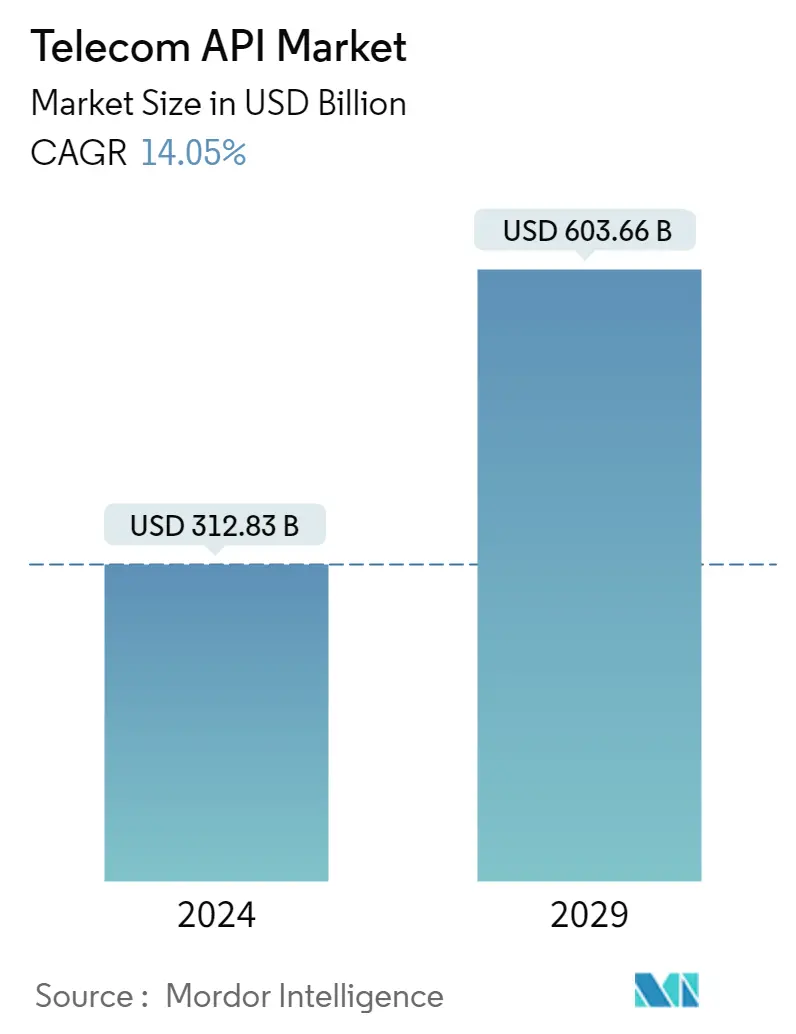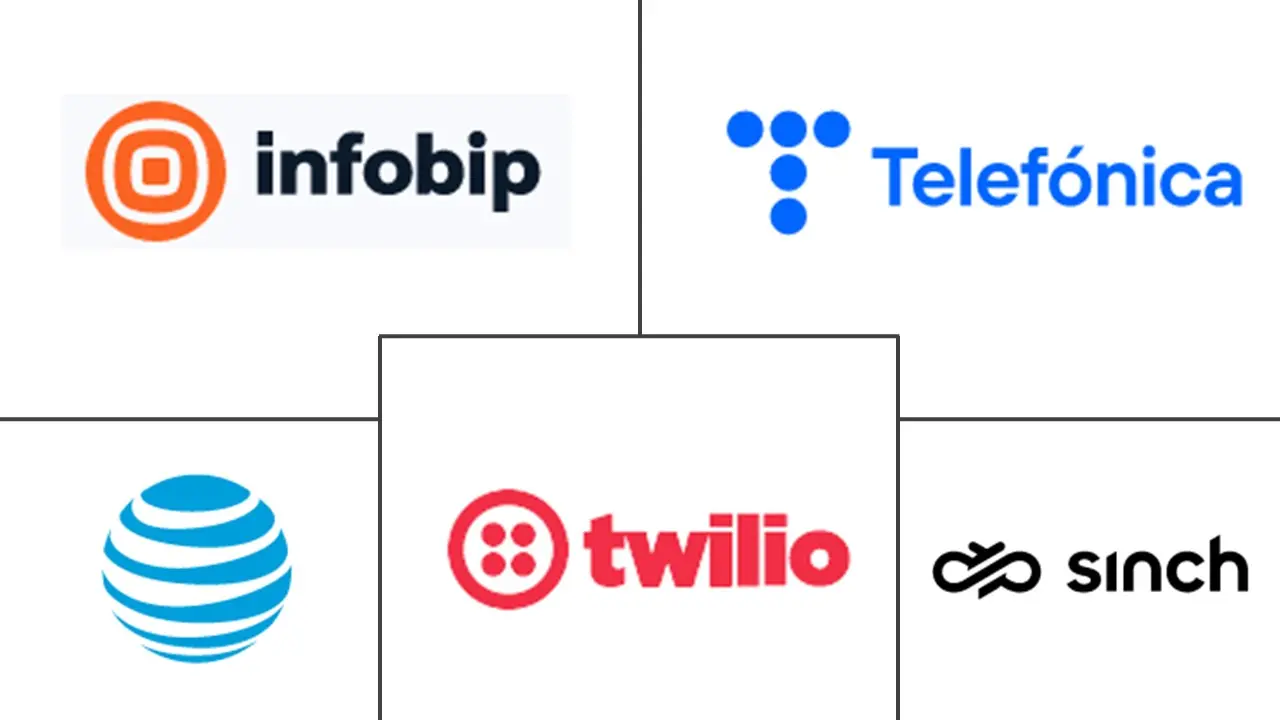Market Size of Telecom API Industry

| Study Period | 2019 - 2029 |
| Market Size (2024) | USD 312.83 Billion |
| Market Size (2029) | USD 603.66 Billion |
| CAGR (2024 - 2029) | 14.05 % |
| Fastest Growing Market | Asia Pacific |
| Largest Market | North America |
| Market Concentration | Low |
Major Players
*Disclaimer: Major Players sorted in no particular order |
Telecom API Market Analysis
The Telecom API Market size is estimated at USD 312.83 billion in 2024, and is expected to reach USD 603.66 billion by 2029, growing at a CAGR of 14.05% during the forecast period (2024-2029).
A telecom API (application programming interface) is a set of protocols, tools, and definitions that allow different software applications to communicate and interact with telecom network services, such as voice calling, messaging, location services, and payment processing. Further, the proliferation of smartphones and the increasing popularity of mobile apps created a significant demand for telecom APIs, often used to enhance app functionality. According to Ericsson, smartphone mobile network subscriptions worldwide reached almost 6.7 billion in 2023, and they are expected to exceed 7.7 billion by 2028.
- Telecom companies are undergoing digital transformation to stay competitive. APIs enable integration between different systems and facilitate new digital services. Telecom operators are leveraging APIs not only for service delivery but also for generating additional revenue streams through API monetization models such as revenue sharing and subscription-based pricing.
- For instance, in May 2024, Digital Nasional Berhad (DNB) and Ericsson announced a program to catalyze the digitalization of enterprises in Malaysia, enabled by the capabilities of the world-leading 5G network. These pioneer industry initiatives will pave the way for advanced technologies to enable the digitalization of enterprises across different industry verticals and drive Malaysia forward as a leading digital nation.
- The proliferation of IoT devices requires seamless connectivity and communication between devices and backend systems. Telecom APIs provide the necessary interfaces for device management, data exchange, and control, supporting the growth of the IoT ecosystem. According to IHS, more than 75 billion Internet of Things (IoT) connected devices will be in use by 2025.
- The recent increase in the number of startups launched in the field of telecom API in markets such as Asia-Pacific and Africa is anticipated to open unique opportunities for telecom API service providers during the forecast year. Industry giants such as Vodafone, Google, and communications service providers (CSPs) and technology supplier groups have created partnerships with startups from these emerging markets to complete a nurturing ecosystem for the growth of telecom startups by offering their APIs for application developments, thus propelling the market’s growth. For instance, in November 2023, major players like Twilio and Nexmo integrated AI into their APIs, making them more innovative and efficient for automating tasks and personalizing communications.
- Moreover, compatibility issues with existing legacy systems obstruct the seamless integration of APIs. The integration of APIs faces considerable challenges due to compatibility issues with legacy systems. These hurdles stem from the significant differences between the architecture and technology of older legacy systems and the requirements of modern APIs. Often, legacy systems need more flexibility, standards compliance, and adaptability to connect with newer APIs seamlessly. These challenges include technological disparities, data formats, security protocols, and scalability between legacy systems and modern API standards. Addressing these challenges is critical to harness the potential of modern APIs within existing systems.
- At the time of the COVID-19 pandemic, telecom API vendors developed solutions to cope with the situation for better accessibility by implementing strategies such as new product developments, mergers and acquisitions, and geographical expansion. For instance, in March of the previous year, US-based T-Mobile Venture invested in telecom API development startup Signalwire, which develops voice, video, and messaging APIs to advance API and 5G technology, among others.
- In addition, the Russia-Ukraine War disrupted infrastructure and internet connectivity in the region, leading to service interruptions for telecom API providers and their customers. Such geopolitical tensions may result in regulatory changes or sanctions affecting cross-border business operations, potentially complicating partnerships and transactions in the telecom API market.
Telecom API Industry Segmentation
Telecom API is a set of standard software functions that an application can utilize to operate the networking architecture. The API bridges the combination between the application and the resources across the device. Telecom APIs are the medium for accessing telecom services and data for multiple communication-enabled applications. Telecom providers are leveraging APIs to create differentiated offerings. APIs enable providers to combine their services and systems with third parties, opening up more rapid partnership opportunities that produce innovative, high-quality services. The telecom API market is segmented by type of service (messaging API, IVR/voice store and voice control API, payment API, webrtc [real-time connection] API, location and map API, subscriber identity management and SSP API, and other types of services), deployment type (hybrid, multi-cloud, and other deployment types), end user (enterprise developer, internal telecom developer, partner developer, long tail developer), geography (North America, Europe, Asia-Pacific [China, South Korea, Australia, New Zealand, India, Thailand, Singapore, Malaysia, Rest of Asia-Pacific], Latin America, and Middle East and Africa). The impact of macroeconomic trends on the market is also covered under the scope of the study. Further, factors affecting the market's evolution in the near future, such as drivers and constraints, have been covered in the study. The market sizes and predictions are provided in terms of value (USD) for all the above segments.
| By Type of Service | |
| Messaging API | |
| IVR/Voice Store and Voice Control API | |
| Payment API | |
| WebRTC (Real-Time Connection) API | |
| Location and Map API | |
| Subscriber Identity Management and SSO API | |
| Other Types of Service |
| By Deployment Type | |
| Hybrid | |
| Multi-cloud | |
| Other Deployment Types |
| By End User | |
| Enterprise Developer | |
| Internal Telecom Developer | |
| Partner Developer | |
| Long Tail Developer |
| By Geography | |||||||||||
| North America | |||||||||||
| Europe | |||||||||||
| |||||||||||
| Latin America | |||||||||||
| Middle East and Africa |
Telecom API Market Size Summary
The telecom API market is poised for significant growth, driven by the increasing demand for seamless integration between software applications and telecom network services. As telecom companies undergo digital transformation, APIs play a crucial role in enabling new digital services and generating additional revenue streams through monetization models. The proliferation of IoT devices and the rise of smartphones and mobile apps have further fueled the demand for telecom APIs, which are essential for enhancing app functionality and supporting device management and data exchange. The market is also witnessing a surge in startups, particularly in regions like Asia-Pacific and Africa, where partnerships with industry giants are fostering a nurturing ecosystem for innovation and growth.
The transition from physical to digital networks in the telecommunications sector is accelerating, with a focus on cloud solutions and microservices to meet consumer demands and improve service delivery. The adoption of hybrid deployment models, combining on-premises infrastructure with cloud services, is enabling telecom companies to maintain control while leveraging cloud flexibility. The introduction of 5G technology is expected to drive further advancements, with telecom companies eager to explore edge computing solutions. Geopolitical factors, such as the Russia-Ukraine war, and challenges with legacy system integration pose obstacles, but government initiatives and funding programs are supporting market expansion. The competitive landscape is intense, with major players like AT&T, Nokia, and Ericsson leading the charge in deploying innovative API solutions.
Telecom API Market Size - Table of Contents
-
1. MARKET INSIGHTS
-
1.1 Market Overview
-
1.2 Industry Ecosystem Analysis
-
1.3 Industry Attractiveness - Porter's Five Forces Analysis
-
1.3.1 Bargaining Power of Suppliers
-
1.3.2 Bargaining Power of Buyers
-
1.3.3 Threat of New Entrants
-
1.3.4 Intensity of Competitive Rivalry
-
1.3.5 Threat of Substitute Products
-
-
1.4 Impact of Key Macroeconomic Trends on the Market
-
-
2. MARKET SEGMENTATION
-
2.1 By Type of Service
-
2.1.1 Messaging API
-
2.1.2 IVR/Voice Store and Voice Control API
-
2.1.3 Payment API
-
2.1.4 WebRTC (Real-Time Connection) API
-
2.1.5 Location and Map API
-
2.1.6 Subscriber Identity Management and SSO API
-
2.1.7 Other Types of Service
-
-
2.2 By Deployment Type
-
2.2.1 Hybrid
-
2.2.2 Multi-cloud
-
2.2.3 Other Deployment Types
-
-
2.3 By End User
-
2.3.1 Enterprise Developer
-
2.3.2 Internal Telecom Developer
-
2.3.3 Partner Developer
-
2.3.4 Long Tail Developer
-
-
2.4 By Geography
-
2.4.1 North America
-
2.4.2 Europe
-
2.4.3 Asia-Pacific
-
2.4.3.1 China
-
2.4.3.2 South Korea
-
2.4.3.3 Australia
-
2.4.3.4 New Zealand
-
2.4.3.5 India
-
2.4.3.6 Thailand
-
2.4.3.7 Singapore
-
2.4.3.8 Malaysia
-
2.4.3.9 Rest of Asia-Pacific
-
-
2.4.4 Latin America
-
2.4.5 Middle East and Africa
-
-
Telecom API Market Size FAQs
How big is the Telecom API Market?
The Telecom API Market size is expected to reach USD 312.83 billion in 2024 and grow at a CAGR of 14.05% to reach USD 603.66 billion by 2029.
What is the current Telecom API Market size?
In 2024, the Telecom API Market size is expected to reach USD 312.83 billion.

